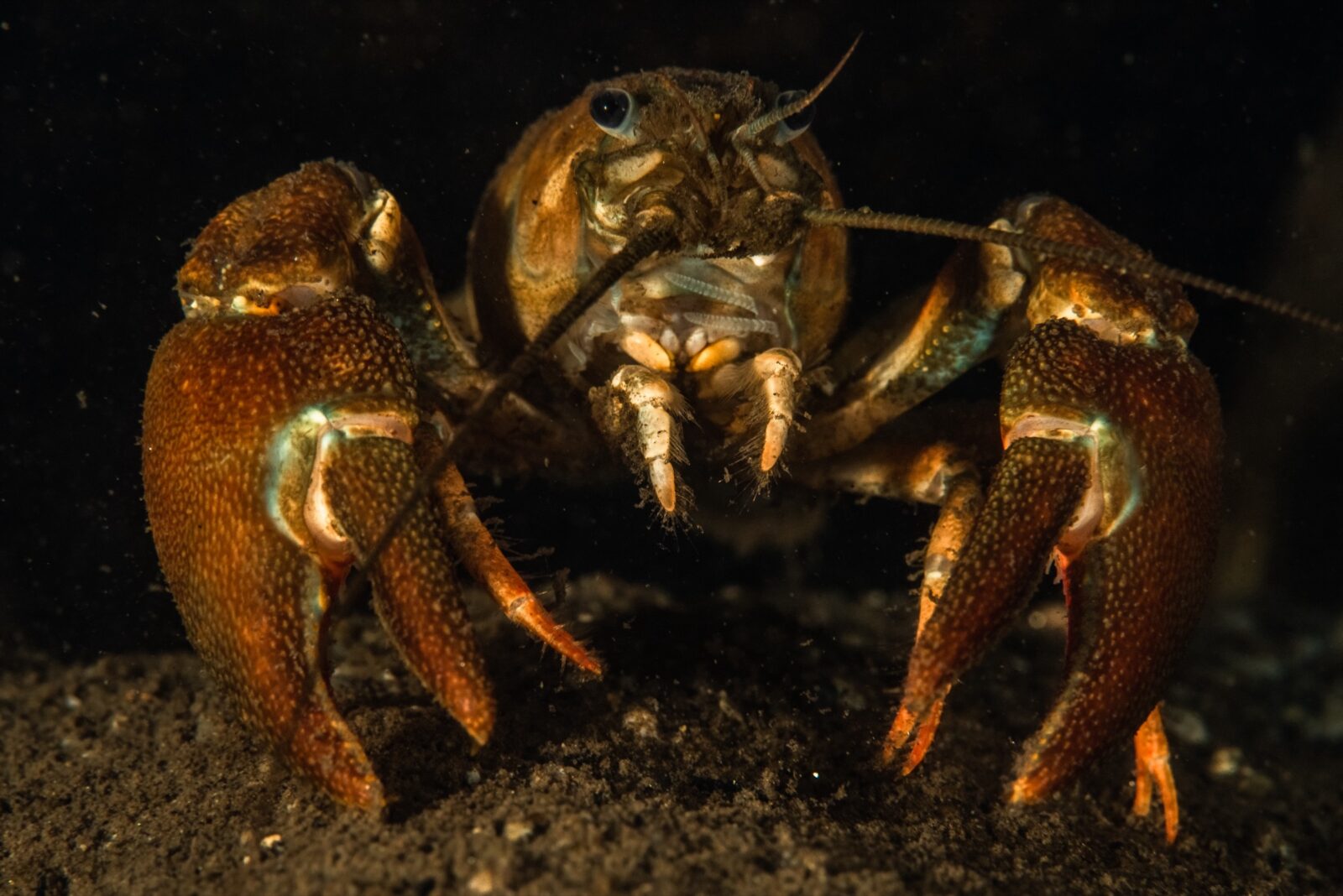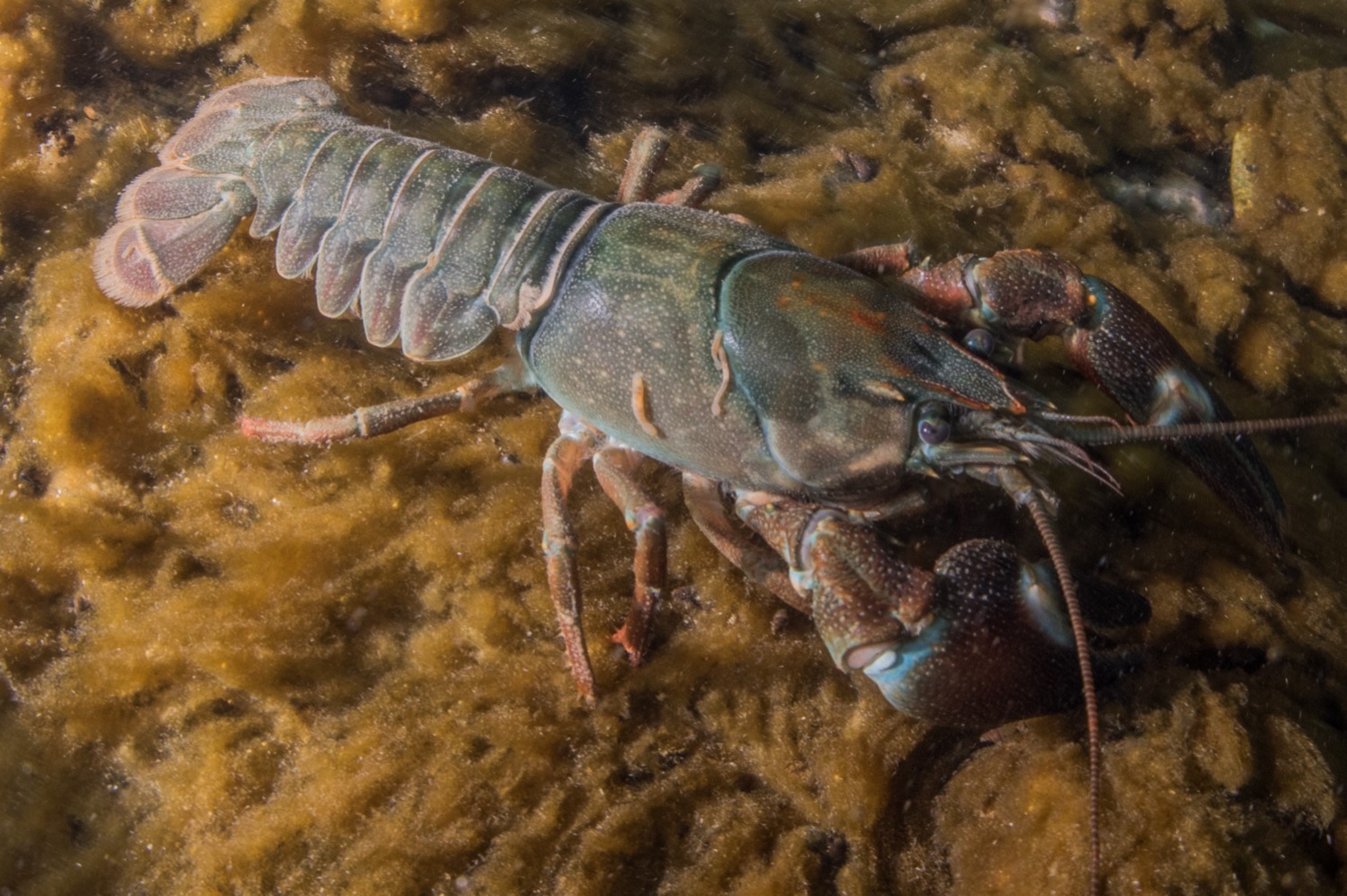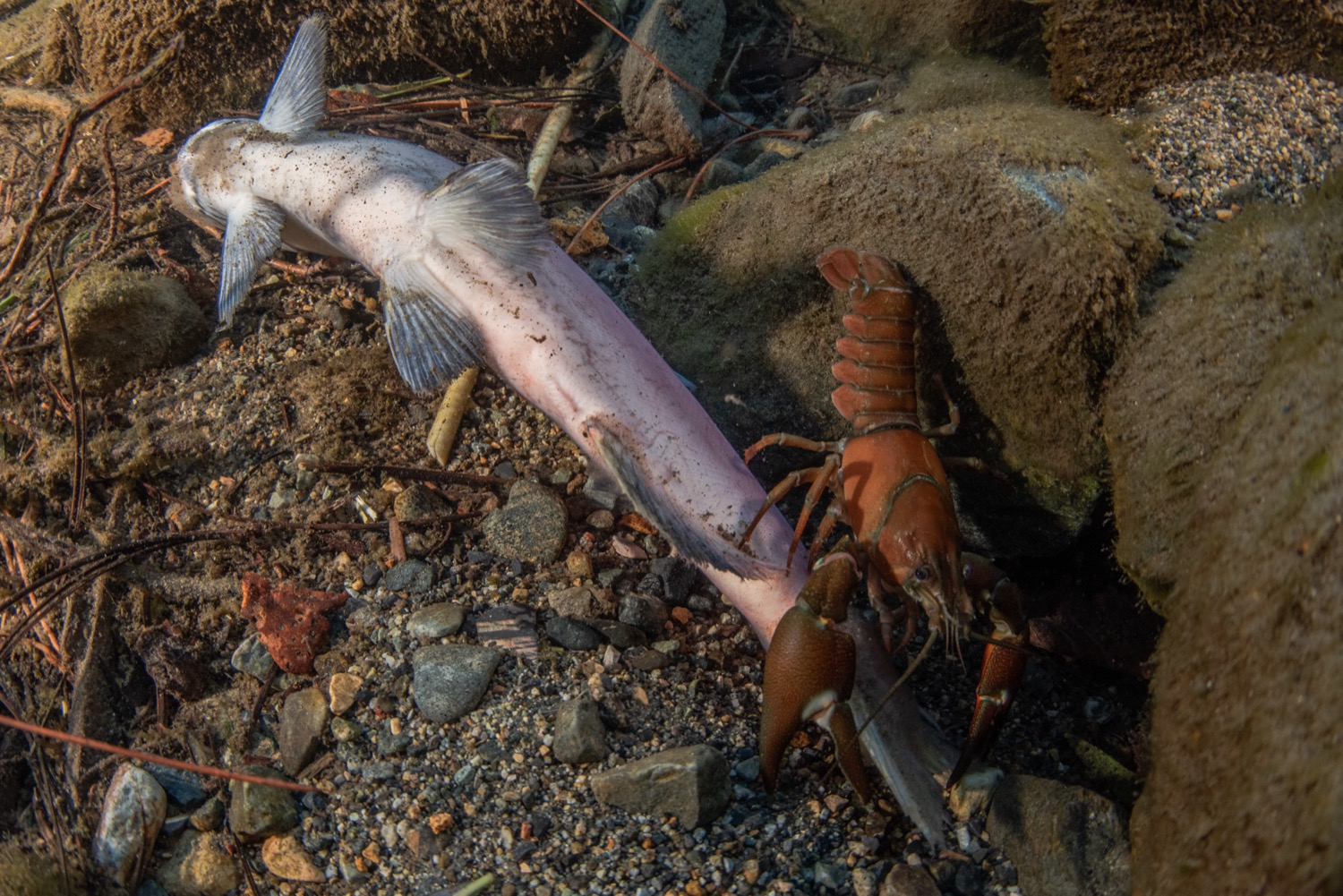[ad_1]


It was a few century in the past that we may be positive a sooty crayfish final ambled throughout the underside of a Bay Space stream—maybe in Alameda, or Pescadero Creek, the place her form had as soon as been widespread. There, she might need nibbled on a snail or fastidiously chosen a pebble, nimbly manipulating it in her petite pincers, to tidy the doorway to the tunnel she had excavated within the riverbank.
Maybe she died peacefully in previous age after failing to discover a mate. Maybe she was crushed in a heron’s beak, or by the claws of an invading crayfish species. Possibly she was step by step blanketed and smothered by a layer of choking silt from the canals being constructed upstream. All we know is that she was the endling—the final surviving member of her species—for someday after the species was final seen within the late 1800s, the sooty crayfish quietly vanished.
Crayfish, the freshwater counterparts to lobsters, are ubiquitous but ignored. Curious youngsters pluck mudbugs, crawdads, or crawfish—all crayfish by one other identify—from the shallows, generally incomes a painful pinch as a reward. Others purchase them by the bushel to pile excessive at crayfish boils. “I believe folks usually assume {that a} crayfish is a crayfish—they’re all the identical, a cosmopolitan [species] that lives all over the place on Earth,” says Eric Larson, an ecologist and affiliate professor on the College of Illinois Urbana-Champaign, who research crayfish invasions and declines. “That’s not the case.” These humble denizens of the shallows are, the truth is, keystone species and ecosystem engineers that play an outsize function of their habitats—and completely different species can have vastly completely different impacts.
North America, the truth is, is teeming with crayfish biodiversity, with some 400-odd species dwelling from roadside bogs to mountain streams, however most of that range is within the southeastern U.S. California—in different respects a biodiversity hotspot—is of course depauperate within the crayfish division. The entire state had simply three native crayfish species, all from the identical genus, Pacifastacus: the sign crayfish (P. leniusculus), primarily a Pacific Northwest cray whose pure vary barely dipped into CA; the endangered Shasta crayfish (P. fortis), named after its single house county; and the sooty, (P. nigrescens), our solely native Bay Space species, which was discovered nowhere else on the planet. And now simply two native species stay in California.
The sooty crayfish was virtually definitely well-known to the Miwok and Ohlone, although the archaeological proof is scant—crayfish shells are notoriously skinny and brittle, and don’t persist for lengthy in middens. However numerous different crayfish species are recorded as meals sources for different Indigenous peoples throughout North America and elsewhere. The crayfish would have then come to the eye of frontiersmen and settlers, all of whom used it as a meals supply.
A Western scientist first observed the sooty within the mid-1850s, a time of explosive inhabitants progress for San Francisco and California as 1000’s of prospectors surged in from the East following the invention of gold in 1848. William Stimpson, a younger biologist surveying the West, stumbled throughout the crayfish at a fish market in San Francisco. Stimpson remarked on its ‘slender palms missing pubescence’ (hairs), famous points of the chitinous spikes on the exoskeleton that differentiated it from related species, measured it to be about 3 inches in size, and noticed that it was widespread within the waterways round San Francisco. Stimpson roved throughout the West and have become a famend marine biologist, describing 948 species. Ultimately, he lugged his treasured specimens, together with the sooty, to Chicago, taking a job as director of the Chicago Academy of Sciences. The primary specimen {that a} description is predicated on, known as a holotype, was meant to be stored preserved eternally in order that future generations may refer again to it. Unluckily, the sooty holotype burned within the Nice Chicago Hearth, with numerous different specimens. On reflection, you would see the tragedy as a portent of the species’ destiny.
Ancestors of the sooty crayfish arrived within the San Francisco Bay Space from the north someday in the course of the Pleistocene—that’s, between 2.5 million and 12,000 years in the past. A wide range, I do know. I spent a while making an attempt to slender it down—however with restricted specimens and no fossil information, that will be fairly the scientific journey. Anyway, we do know ancestors of the sooty crayfish crawled south via rivers, creeks, and presumably floodwaters from nice glacial soften occasions. When situations modified, Bay Space crayfish had been reduce off from different crayfish for millennia. Remoted, they speciated—and together with them, so did their many hitchhikers.

For every crayfish is a world unto itself, a number of tiny passengers. These plastered on their shells embrace leech-like crayfish worms (Branchiobdellidans) and bean-shaped seed shrimp (Entocytherids), symbiotic organisms that reside on the crayfish, concentrate on selecting meals from their exoskeletons, and depend on their hosts to finish their life cycles. Bronwyn Williams, an invertebrate analysis curator on the North Carolina Museum of Pure Sciences who researches crayfish and their hangers-on, has seen as many as eight species on a single crayfish, and describes every cray as a posh panorama. She marvels that the tiny creatures “partition themselves into microhabitats on the crayfish, primarily establishing their very own little properties. One species could happen on the claws, whereas one other happens on the underside of the tail.” Crayfish actual property isn’t the one place these micro-critters differ—Williams says “species have wildly completely different behaviors as properly. Some are gradual and sort of dopey, some are actually quick and squirrelly.” Usually, they’re neither parasites nor freeloaders: one 2020 examine on an East Coast species discovered that crayfish with these symbionts grew quicker and had been extra energetic than these with out. A few of these shell-inhabiting worms and shrimp are completely happy on any previous crayfish, however many are uniquely tailored to life on a single species. We’d want a time machine to look at the symbiotic species that adhered to the sooty’s shell, as even museum specimens weren’t maintained in a method that will have preserved their little passengers. They may have been thrown out throughout adjustments of preserving alcohol and formalin, or just mistaken for disposable gunk on the backside of a jar. However we may be virtually optimistic that they’d have been distinct. To them, the sooty crayfish had been a one-stop touring nursery, buffet, motel, and in the end—with no new hosts to leap to, a hearse.
After its entrée into the scientific world, the sooty crayfish remained out of the general public eye because the world modified round it. San Francisco grew to become the fastest-growing metropolis in North America, and from 1860 to 1920, the inhabitants of the Bay Space counties grew tenfold. This speedy urbanization and industrialization introduced drastic adjustments to the watersheds; elevated air pollution, waterways had been drained, crammed in, or redirected, expunging the sooty from its former haunts. Remaining people had been probably shoved to the margins of their habitat.
It’s a globally widespread sample, and one I see with Bay Space species of concern that I work with as a wildlife biologist. So many native species solely persist within the areas that people deem undesirable for growth. The San Francisco garter snake or Alameda striped racer, each of which misplaced habitat when the areas quickly urbanized. The California tiger salamander, which had the unhealthy luck of counting on vernal ponds that had been transformed to agricultural makes use of.
The demise knell for the sooty crayfish most likely sounded with the introduction of its cousin from the north—the sign crayfish. Rising as much as 8 inches lengthy, and brandishing beefy pincers, in distinction to the sooty’s delicate appendages, the sign cray was greater than twice the sooty’s dimension. And it was voracious, consuming the whole lot the smaller sooty may and extra—together with, fairly probably, the sooties themselves. An early report noticed sign crays within the Bay in 1898, however they appear to have remained sparse for years after that. In 1912 the invasion escalated—with human help. Folks had acknowledged how scrumptious crayfish had been, and their taste was their ticket all over the world. Sign crayfish had been launched, most likely deliberately, into the San Lorenzo River, close to Santa Cruz, from the California Fish and Wildlife Fee’s Brookdale Fish Hatchery. Maybe the hatchery employees didn’t distinguish between native sooty crayfish and the imported selection they had been releasing; maybe they figured the river already had crayfish in it, so why not add some extra? How the sign crayfish made it to close by waters isn’t clear, however, nevertheless, the outcomes are in—as we speak, they’re present in waterways in each Bay Space county. In city and distant streams alike, the sign crayfish marched in and summarily ate their meeker family members.
These Bay Space streams, being comparatively wholesome and undisturbed, are simply the kind of locations a sooty crayfish might need inhabited a bit of over a century in the past. On the left is Lagunitas Creek in Marin; the correct is a North Bay creek backside the place solely sign crayfish may be discovered these days. (Anton Sorokin)
And no one, it appears, did something to cease them. Combing via public statements, articles and dispatches from freshwater ecologists, naturalists, and state companies within the early 1900s, I may discover no proof that anybody ever tried to preserve or save the sooty crayfish, or that individuals even observed its decline whereas it was occurring. In all probability, the overwhelming majority of people that did come throughout crayfish failed to acknowledge that there have been two distinct species, and one was being changed by the opposite. I may see that within the 1800s, the sooty was described as a typical creature—after which for some years, the report goes virtually darkish, till biologists within the mid-1900s began remarking that the sooty was notably lacking and had been for a while. Sign crayfish had been by then, nevertheless, plentiful. Within the subsequent hundred years, the sign would conquer the whole state of California, and two new invaders would arrive—the virile crayfish (Faxonius virilis), from the Nice Lakes area, and the crimson swamp crayfish (Procambarus clarkii), from Louisiana and Texas.
So within the Bay space, we misplaced one species of crayfish and gained three. “We could by no means know what all was misplaced with the extinction of the sooty crayfish,” Williams says, however this seemingly small shift in crustacean populations probably had main panorama results.
Crayfish species don’t all behave the identical, and so they play completely different roles of their underwater communities. Some dig burrows, like our crimson swamp crays; others can’t. Some are extremely predatory, just like the sign cray; others are largely herbivorous. Many times in our trendy age, we’ve seen how non-native species—whether or not widespread ivy or crayfish—can reap the benefits of their new environment, when free of the constraints that stored them in test of their native ranges. They’ll attain larger densities than they ever did of their native ranges. They price us thousands and thousands of {dollars} a yr, and trigger many sudden penalties—a few of which can be paid for with blood, actually … The following time you’re swarmed by mosquitoes, invasive crayfish will be the ones accountable. In California, a examine linked crimson swamp crayfish to elevated mosquito swarms. Usually, dragonflies hold mosquito populations down, adeptly preying on them in any respect life levels. However some crayfish, in flip, prey on dragonfly larvae. Hyperabundant invasive crayfish eat many of the dragonflies, and mosquitos flourish. After all, dragonflies aren’t the one factor being consumed—hordes of invasive crays march round on river bottoms opportunistically consuming larvae and eggs of fish and amphibians, most of the identical species California spends thousands and thousands of {dollars} yearly to preserve. Worldwide, the financial price of sign crayfish invasions was estimated at almost $104 million between 2000 and 2020, whereas the crimson swamp crayfish, no slouch both, was answerable for one other $11.8 million in damages throughout that interval. The researchers who compiled this accounting figured this was most certainly a big underestimate of the true prices.

Native or not, crayfish are busy little mudbugs with an outsize affect. They’re central parts of meals webs, consuming and getting eaten by others—together with terrestrial predators (and when a raccoon will get a crawdad feast it’s serving to transfer vitamins from aquatic methods onto land). Retroactively determining the precise function the sooties and their symbiont communities performed in Bay Space freshwater ecosystems is difficult. “The extinction of a species is excess of the lack of a single organic entity,” Williams says. “On this case we could by no means know what all has been misplaced.”
However taking a look at related species may give us clues. Burrowing crayfish just like the sooty create habitat that can be utilized by small fish and invertebrates, just like the function that floor squirrels play on land. The crayfish clip plant roots, transfer massive quantities of soil, and help fuel alternate, by releasing it from soils to areas the place it may be utilized by vegetation and animals. Native vegetation and animals advanced alongside the sort of low-grade disturbance the sooties would have supplied. Now, launched crayfish can burrow too—however as a result of there are much more of them than there ever had been native crayfish, their out-of-control excavation can destabilize riverbanks, kill aquatic vegetation, muddy the water, and even change the paths of rivers. When crayfish murk up the waters, different issues die or go away—and a cascading discount within the range and abundance of aquatic vegetation, invertebrates, amphibians, and birds can comply with. Some crayfish-rich stretches of a stream in Southern California had been discovered to have a decrease aquatic invertebrate range, which in flip restricted meals sources for state threatened steelhead trout and newts.
The sooty’s unhappy story is a cautionary story, as different native crayfish within the West are going through the identical issues that took it out. “In the event you don’t wish to discover these species on the brink of extinction in 2100,” Larson says, “the time to be proactive is now.”
However I questioned. Might sooty crayfish have secretly survived? Higher know-how, elevated public curiosity, and telephones in each hand have led to constant species rediscoveries. In 2020, an iNaturalist person within the Sierra rediscovered, whereas gardening, a cicada not seen since 1915. A clam thought of extinct because the Pleistocene was present in a tidepool off Santa Barbara’s coast. Even different crayfish have returned from the supposed useless: final yr, an Alabama cave crayfish was discovered after being presumed extinct for greater than 30 years. Possibly sooty crayfish dwell out of sight on the backside of creeks within the Bay Space?
Given the density of crustacean fanatics—scientists at universities or museums, different scientists, anglers, and others—Larson doesn’t assume so. “It’s not a spot the place I believe biologists or zoologists have been prone to miss this animal for a half-century or extra.” However he provides, “In the event you discover an attention-grabbing crayfish within the Bay Space, take a photograph and add it to iNaturalist, or ship a picture to a researcher.” Larson would love, he says, to be proved incorrect.
[ad_2]

